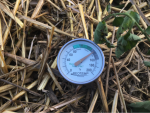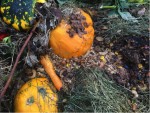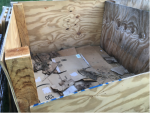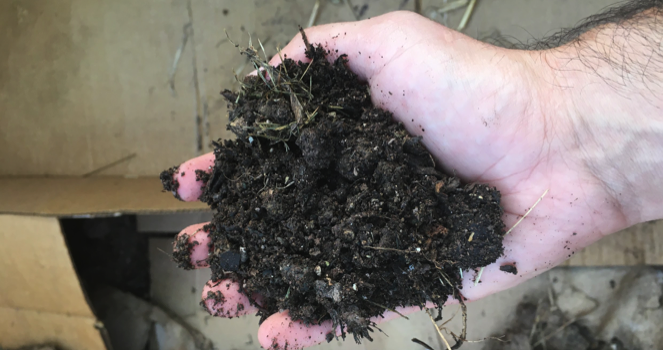(Continued from Part 1. This concludes the article.)
After your pile is built you wait. The microbes do the work. One helpful tool in this part of the process is a compost thermometer that will probe temperatures 18”-24” into the pile. The internal temperature tells you what is going on inside the pile so you know when to turn the pile. We will only be turning the pile once.
 As you can see this pile is cooking at around 140 degrees, which means my microbes are in turbo mode. You probably don’t want it much hotter than this. The lower portion of this pile is probably not that hot since the bottom of the pile is ~5 months old and has already decomposed quite a bit. If I were to insert a metal rod into this pile and pull it out after a minute, the end of the rod would be almost too hot to hold. This pile has been between 120-140 degrees for several months as I keep adding to it. This is why manure, weeds, and diseased plants can be put in compost. The heat, and beneficial microbes take over and wipe out most of the bad stuff. However, please use common sense, compost won’t kill everything, so don’t treat it like a hazmat disposal. If you know the material contains human or animal biohazard or a recurring soil disease/pest organism, find somewhere safe to dispose of it.
As you can see this pile is cooking at around 140 degrees, which means my microbes are in turbo mode. You probably don’t want it much hotter than this. The lower portion of this pile is probably not that hot since the bottom of the pile is ~5 months old and has already decomposed quite a bit. If I were to insert a metal rod into this pile and pull it out after a minute, the end of the rod would be almost too hot to hold. This pile has been between 120-140 degrees for several months as I keep adding to it. This is why manure, weeds, and diseased plants can be put in compost. The heat, and beneficial microbes take over and wipe out most of the bad stuff. However, please use common sense, compost won’t kill everything, so don’t treat it like a hazmat disposal. If you know the material contains human or animal biohazard or a recurring soil disease/pest organism, find somewhere safe to dispose of it.
I checked the temperature about 6” from the edge of the pile on the same day in the same pile. The temperature was about 20 degrees cooler than the center, but that is still very warm. This means the material is decomposing all the way to the edge of the pile. This is why I used solid sides for my bins.
After I finish adding materials to a pile, I monitor the temperature of the pile. When the temperature drops to near ambient temperature I know the microbial processes are stabilizing and the pile is ready to turn. If you are not monitoring temperature actively you will want to wait 3-4 months from when you stopped adding materials to the pile. If the pile was finished in late fall, you will want to add a couple months since winter temperatures can slow the process down. The other major consideration while waiting for the pile to finish is moisture. If you live in a wet climate you may wait to cover your pile or build a roof over your bins. If the piles get soggy it will slow down the process, and might stink. If you live in an arid climate you may want to cover your pile to keep moisture in, and you will probably need to water your little microbe workers to keep them cranking away.
When the pile is ready to be turned, I take some of the sides off for easier access and fork the pile over into the adjacent bin, put the sides back on, and leave it for about three months. The pile will probably heat back up again due to all the extra oxygen, but will not get nearly as hot as the fresh materials did. After it cools, additional organisms that cannot survive the high heat of the initial pile will move in and help finish the pile (earthworms for example). It is important to allow time for this to happen.
You want a balanced finished compost. It is hard waiting for your first batch, but if you are always building new piles, you will be producing a continuous supply of compost. Some people advocate turning compost more often to speed up the process. It will certainly help break down the organic matter faster, but I expect there will be a tradeoff. If you are constantly turning your pile and keeping it in high heat mode, you will not get a balanced mix of microorganisms in your compost. Remember, we are trying to mimic the natural system which means a balanced mix of soil organisms. Most of them will not be present in a high heat environment.
 This photo is of compost from a pile that is almost finished up. After the initial decomposition and turning it has compressed to half the initial volume. The compost has a fresh earthy smell, is moist and crumbles easily in your hand.
This photo is of compost from a pile that is almost finished up. After the initial decomposition and turning it has compressed to half the initial volume. The compost has a fresh earthy smell, is moist and crumbles easily in your hand.
Some Miscellaneous Considerations:
- Meats/fats/bones/dairy are not added to the compost pile (eggshells can go in). They break down slowly and mess with the balance of the pile. Bones don’t break down at all. The good news is that most of these items can go to your chickens.
- Sticks, wood cuttings, and branches are not added to the pile unless shredded very fine in a wood chipper, and then only in small amounts. They are high in carbon and will not break down in the 8-9 month compost process unless they are very small pieces. Wood chips can be piled up and aged for 1-2 years to break them down. After aging they can be used as a great garden mulch or added into the compost as a brown layer.
- Coconut shells DO NOT compost. I made the mistake of throwing these in one year, and I am still picking the pieces out of my garden years later.
- Be careful to remove produce stickers or you will find them in your garden later. They do not break down.
- When adding kitchen scraps to the pile, add a good covering to prevent attracting pests, and prevent smells. Grass clippings work great. I keep a spare pile next to the bin and the boys throw some on every time they take a bin of scraps out. When I run out of clippings to cover the scraps I end up with a maggot farm.
 Once you start composting and experience the value it brings to your garden, you will realize you need more materials for your pile. You will become a weirdo who runs a neighborhood yard waste center in your backyard. You will watch your neighbors doing yard work and offer to “help” empty their wheelbarrow as soon as it is full of glorious yard clippings and weeds. Instead of dumping at the community yard waste center you will show up with an empty trailer and fill it with the best clippings you can find. This may sound like hyperbole, but I have actually done all these things to help fill my bins.
Once you start composting and experience the value it brings to your garden, you will realize you need more materials for your pile. You will become a weirdo who runs a neighborhood yard waste center in your backyard. You will watch your neighbors doing yard work and offer to “help” empty their wheelbarrow as soon as it is full of glorious yard clippings and weeds. Instead of dumping at the community yard waste center you will show up with an empty trailer and fill it with the best clippings you can find. This may sound like hyperbole, but I have actually done all these things to help fill my bins.
Ideas For Filling Your Bins:
- Grass clippings from untreated lawns, pulled weeds, and similar non-woody yard waste
- Kitchen vegetable scraps
- Neighbors may be happy to get rid of their yard clippings and leaves without having to run to the yard waste center (if they use chemicals or spray/treat their lawn then this is not a good option).
- Grazing animal manures. JWR Adds: Preferably cattle rather than horses, so any seeds they eat won’t sprout.
- Yard waste facilities often offer materials to residents. I can pick up wood chips by the trailer load, and will be scrounging leaves this fall for compost, and for making leaf mold (leaf mold is an anaerobic composting method). JWR Adds: In compost, keep the percentage of wood chips low.
- Local farmers may have various kinds of excess materials that you can get for free or at a low cost such as old stable bedding, straw or hay that has gone bad, etc…
- Do you have a local coffee shop? Coffee grounds are nitrogen-rich “green” material. Maybe they will fill some buckets for you to pick up weekly.
*Please be careful to screen your material sources. If there are chemicals/pesticides in the plant residues you gather they will end up in your compost, your garden, and by extension you. They may also inhibit the microbes in your pile.*
Using Compost
How you use your compost will depend on your gardening method of choice. Many people choose to till their gardens, and simply spread the compost and till it into the soil. I use a “no dig” gardening method. I like to think it is because I am a sophisticated, scientific grower who works with nature, but I’m probably just lazy. However, no-dig gardening has three main advantages, namely:
- No digging
- No digging
- No digging
As you can see from that comprehensive list, “no-dig” gardening has a lot going for it. But on a serious note, I do really believe the no-dig method has many advantages for anyone growing on a small scale (ie. home gardeners, homesteads, small market gardens). Large scale farm crops will usually require tilling to prep and plant entire fields in an efficient manner. Once established, no-dig gardens experience much less weed pressure, the soil structure and soil organisms are not disturbed and remain much more active. Compost and amendments can simply be layered on top of the soil and will be integrated into the soil over time producing long term benefits. No-dig gardening mimics the natural processes we discussed earlier with organic matter accumulated at the surface and slowly worked into the soil over time as it decomposes.
I use my compost in two ways. First as a top dressing on previously established garden beds. Depending on the bed and number/type of crops planted that season I may spread ½”-1” of compost on the bed. The other way I have used compost is as a deep layer 3-4 inches on a new garden bed. New plants are planted directly into the compost layer, and the roots will reach down into the subsoil.
 I place a layer of cardboard under the compost, which smothers existing weeds until the bed is established. The beds where I have used this method have required virtually no weeding, at least not from weeds growing from below. A few new seeds find their way on top of the beds, but the baby weeds are easily dealt with. My spring carrots were planted in 2 beds that had been established with this method. I harvested over 50lbs of carrots in 70 sq/ft of garden space. The carrot roots extended well down into the soil layer, sometimes 7″-to-8″ below the upper compost layer.
I place a layer of cardboard under the compost, which smothers existing weeds until the bed is established. The beds where I have used this method have required virtually no weeding, at least not from weeds growing from below. A few new seeds find their way on top of the beds, but the baby weeds are easily dealt with. My spring carrots were planted in 2 beds that had been established with this method. I harvested over 50lbs of carrots in 70 sq/ft of garden space. The carrot roots extended well down into the soil layer, sometimes 7″-to-8″ below the upper compost layer.
Compost Holds Moisture
Compost helps my garden soil retain moisture. The beds where I use a thick top layer of compost hold moisture remarkably well. I do not live in an arid climate, but our summers can have extended dry spells. It is not unusual to have a two-week spell of heat without rain during the summer, yet I rarely have to water the garden. Even when the top compost is dried out, digging down to soil level reveals moisture in the soil. The compost acts as a covering mulch and the soil does not dry out.
Back to our example of natural compost in the woods. Have you ever dug into the dry leaves in the summer? How far down do you have to dig to find damp soil? Not very far because all the organic matter on top prevents the moisture from evaporating. There are still times the plants need to be watered to get the best results. But it is nice to know my compost builds in an additional margin of protection in case of a drought. What if I was depending on this crop? What if something happens to my rain collection system (like a child who doesn’t turn off the spigot)? Losing the whole garden to drought could be a very serious situation.
I don’t think any long term self-sufficiency plan is complete without a way to produce the bulk of your own food through gardening/farming. Each crop you grow extracts material from your soil, and without replenishing the soil eventually you will deplete the fertility of your land. Compost is the number 1 way to restore your soil, minimize the nutrient extraction, and build long term soil fertility and sustainability.
I hope this guide has given a clear idea of how to start your own composting experiments, or some new ideas for those who already compost. During my time as a SurvivalBlog reader I have learned many tips and ideas from all of you, and I hope this article begins to pay back some of my debt of knowledge. It is encouraging to know others are working towards similar goals of self-sufficiency and freedom.
Here are links to some great videos by expert market gardener Charles Dowding who uses the same composting method (in fact the whole channel is helpful if you want to look into the “no-dig” gardening method):











I have a cattle auction house near me. I used to get manure there. But then I ended up with a whole section of my garden dead. Found out there is a herbicide used on hay that survives the digestion process. I stopped using their manure. As it is very difficult to determine herbicide content in purchased hay, even manure from a small hobby farm could be a problem, unless they grow 100% of what their animals consume.
Hey Hobbit Farmer, excellent article.
I agree that solid sides to the compost pile are the best way to go. My two piles have sides constructed with pallets, two old-time bed springs that I needed to get rid of, and t-posts to hold it all up. To make solid sides, I used salvaged plywood that was too damaged for use elsewhere and scraps left over from putting metal roofing on my house and shop. Surprisingly the plywood has held up for 7 years now. When I get rich and famous, I’m going to build two bins from concrete blocks with a concrete floor.
Is there a particular compost thermometer you’d recommend?
My biggest brain cramp with composting was assuming that hardwood sawdust would compost much more slowly that softwood. I had problems getting my normal sawdust from the mill this year due to the virus and just barely googled it right now. Hardwood sawdust composts 2-4 times more quickly than softwoods. Wow. It must be all the resins in softwoods. I can get all the hardwood sawdust I can use from a cabinetmaker friend and he has trouble getting rid of it. So it’s a win-win I should have googled this ten years ago.
Here’s a link with some decomposition numbers. The higher the number, the more quickly it composts.
https://www.grovida.us/composting-guide/sawdust-decomposition.html
RATE
Red Cedar 3.9
Douglas Fir 8.4
White Pine 9.5
Western White Pine 22.2
Chestnut 33.5
Yellow Poplar 44.3
Black Walnut 44.7
White Oak 49.1
Average of all hardwoods . . .45.1
Wheat straw 54.6
The lower the number, the slower the decomposition rate. Hardwood sawdust decomposes faster than softwood sawdust.
Source: Haug, Roger T. (1993). The Practical Handbook of Compost Engineering.
Thanks again for taking the time to put this article together.
St Funogas thanks for the info on sawdust decomposition. I didn’t realize that hardwood sawdust breaks down faster. It makes sense with all the resins in most softwoods.
We have pallet bins for most of our garden scraps that I don’t feed to our chickens that are made out of pallets. Your way is very informative and efficient. But I take a very easy way. I just pile the stuff and 2 years later we take our little Mantis tiller and till it up and then spread it over our garden. For our chicken coop bedding we just pile it up and do the same way . It might be slower but it works the same. Compost is so beneficial for your gardens and I agree that everyone should be making and using it.
Growing up in FL, my pediatrician told my mother to buy canned or out of state vegetables, because the locally grown vegetables were nutritionally deficient, although they looked really good. Other areas may have the same issue. Compost is a very important component of home food production.
After years of trying to amend the soil for local gardens, we switched to the Square Foot Gardening methodology. Mel’s soil mix uses one third part compost, and compost is added to the beds each year.
Some folks buy bagged compost, and there seems to be a good supply of mushroom compost in bulk.
But, it is more economical to produce your own compost and you know what is in it.
Leaf shredder, wood chipper, and mulching mower with bag, are some great tools…
Sadly, the once beloved 5 hp rototiller has gone on to greener pastures…
Great articles, thanks for posting…
Anonymous… You make a great point!
From your post: “Growing up in FL, my pediatrician told my mother to buy canned or out of state vegetables, because the locally grown vegetables were nutritionally deficient, although they looked really good.”
I often say that “it may look like broccoli, but it’s not truly complete broccoli in all the ways it should be broccoli!”
As SB readers are aware… This is largely the result of commercial farming practices which arise from commercial farming business models.
If you can grow your produce organically in nutritious soil, get to it!
Produce grown in good soul also tastes better than nutritionally deficient produce grown in depleted soil. Reminds me of Matthew 13:1-9 The Parable of The Sower.
Yes, indeed, BWL! Great thought…
Hobbit Farmer, you have helped readers close the circle of raising food.
Your comment: “The other major consideration while waiting for the pile to finish is moisture. If you live in a wet climate you may wait to cover your pile or build a roof over your bins.” This is important to maintain a steady rate of breakdown. I use a simple tarp upcycled from a roofing job. It keep the moisture level balanced. Furthermore, the tarp keeps the heat from composting in as winter comes on and I reckon gives me 2-3 weeks extension for the materials to break down. I greatly enjoy going out to the car and passing the bin with holes melted through the snow on top of he tarp. A good indicator that the microbes are still busy.
Carry on
Hello Hobbit Farmer!
A question…
From your article: “My spring carrots were planted in 2 beds that had been established with this method.”
I wanted to clarify… Are you saying that you planted the carrots in compost that was resting on top of a cardboard layer? …and if so, how deep such that it did not interfere with the carrots? We have read about the cardboard technique, and haven’t used it yet, but will this year. I don’t think I’ve been so excited about cardboard ever before!
From your post: “Once you start composting and experience the value it brings to your garden, you will realize you need more materials for your pile. You will become a weirdo who runs a neighborhood yard waste center in your backyard.”
This was hilarious, and we know it’s also true! We have become worm tunnel weirdos among other forms of “strange”. Since we don’t participate in social media, we don’t track what people around us might be saying, but we’re sure they’re saying something! It’s ALL GOOD.
Telesilla,
To clarify your question about the carrot beds, those 2 beds had already been established parts of the garden. I converted the beds to raised frame beds with 2×6 frames and filled in with about 5” of compost. I had to regularly weed the previous bedS, but the compost was layered thick enough to virtually suppress all weeds in the soil below. I’m not sure it would be a good idea to put carrots in a new bed with cardboard under, but it could be an interesting experiment to see what the carrots would do. I may have to try it.
I did use cardboard with a wood chip mulch to suppress weeds between rows of asparagus and that virtually eliminated weeds this season in the patch.
Thanks for reading and the great questions!
Paper towels and newspaper also make good carbon-rich additions to the compost. Yep, I’m that weirdo who plucked the paper napkins out of the trash after a potluck, in pre-covid times.
Carry on
The Pictorial Diagram Comparison of the Industrialized World’s Past and Present Food Supply Systems
Store Food Now!
Posted on September 16, 2020
Concerned American
https://westernrifleshooters.us/2020/09/16/store-food-now/
Good article, I am going to use your tips to try to improve my composting. Thanks
I have a problem with tree roots growing up into the compost bin, forming a thick mat I can’t cut through. Any advice?
Noah,
I have never placed compost bins under a tree before so I haven’t run into this problem. You will probably want some sort of barrier under your pile, maybe something like a thick rubber garage floor mat. You could also place a pallet down before starting the pile which will raise it up off the ground and create an air gap the roots won’t bridge. Downside will be critters from the soil can’t move into your pile to help finish it off. If you use a barrier or air gap I would add some shovels of earth to the compost for the final stage to introduce some additional biodiversity.
Noah, I believe he addressed your question in his article. Don’t put your compost bin anywhere near a tree. All the best,
Thanks. My yard is full of trees, so they can’t be avoided.